#convert Meshes to binary format
Explore tagged Tumblr posts
Text
System Shock 2 in Unreal Engine 5
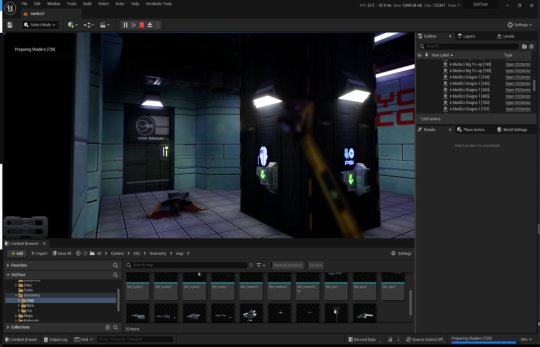
Tools, tools, tools
Back when I worked in the games industry, I was a tools guy by trade. It was a bit of a mix between developing APIs and toolkits for other developers, designing database frontends and automated scripts to visualise memory usage in a game's world, or reverse engineering obscure file formats to create time-saving gadgets for art creation.
I still tend to do a lot of that now in my spare time to relax and unwind, whether it's figuring out the binary data and protocols that makes up the art and assets from my favourite games, or recreating systems and solutions for the satisfaction of figuring it all out.
A Shock to the System
A while back I spent a week or so writing importer tools, logic systems and some basic functionality to recreate System Shock 2 in Unreal Engine 5. It got to the stage where importing the data from the game was a one-click process - I clicked import and could literally run around the game in UE5 within seconds, story-missions and ship systems all working.
Most of Dark engine's logic is supported but I haven't had the time to implement AI or enemies yet. Quite a bit of 3D art is still a bit sketchy, too. The craziest thing to me is that there are no light entities or baked lightmaps placed in the levels. All the illumination you can feast your eyes on is Lumen's indirect lighting from the emissive textures I'd dropped into the game. It has been a fun little exercise in getting me back into Unreal Engine development and I've learnt a lot of stuff as usual.
Here is a video of me playing all the way up to the ops deck (and then getting lost before I decided to cut the video short - it's actually possible to all the way through the game now). Lots of spoilers in this video, obviously, for those that haven't played the game.
youtube
What it is
At it's core, it's just a recreation of the various logic-subsystems in System Shock 2 and an assortment of art that has been crudely bashed into Unreal Engine 5. Pretty much all the textures, materials, meshes and maps are converted over and most of the work remaining is just tying them together with bits of C++ string. I hope you also appreciate that I sprinkled on some motion-blur and depth of field to enhance the gameplay a little. Just kidding - I just didn't get around to turning that off in the prefab Unreal Engine template I regularly use.
Tool-wise, it's a mishmash of different things working together:
There's an asset converter that organises the art into an Unreal-Engine-compatible pipeline. It's a mix of Python scripting, mind numbingly dull NodeJS and 3dsmaxscript that juggles data. It recreates all the animated (and inanimate) textures as Unreal materials, meshifies and models the map of the ship, and processes the objects and items into file formats that can be read by the engine.
A DB to Unreal converter takes in DarkDBs and spits out JSON that Unreal Engine and my other tools can understand and then brings it into the Engine. This is the secret sauce that takes all the levels and logic from the original game and recreates it in the Unreal-Dark-hybrid-of-an-engine. It places the logical boundaries for rooms and traps, lays down all the objects (and sets their properties) and keys in those parameters to materialise the missions and set up the story gameplay.
Another tool also weeds through the JSON thats been spat out previously and weaves it into complex databases in Unreal Engine. This arranges all the audio logs, mission texts and more into organised collections that can be referenced and relayed through the UI.
The last part is the Unreal Engine integration. This is the actual recreation of much of the Dark Engine in UE, ranging all the way from the PDA that powers the player's journey through the game, to the traps, buttons and systems that bring the Von Braun to life. It has save-game systems to store the state of objects, inventories and all your stats, levels and progress. This is all C++ and is built in a (hopefully) modular way that I can build on easily should the project progress.
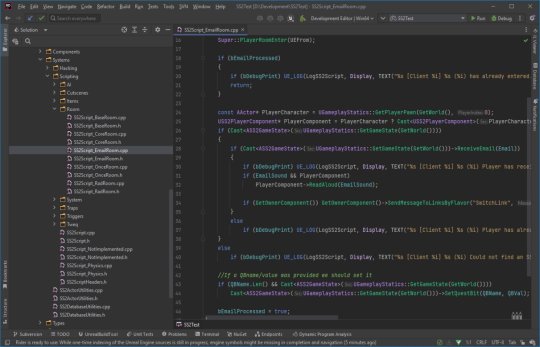
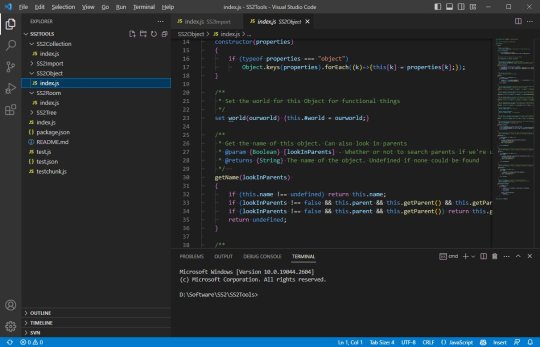
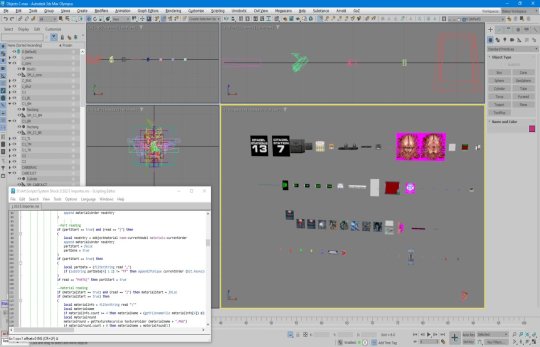
Where it's at
As I mentioned, the levels themselves are a one-click import process. Most of Dark engine's logic, quirks and all, is implemented now (level persistence and transitions, links, traps, triggers, questvars, stats and levelling, inventory, signals/responses, PDA, hacking, etc.) but I still haven't got around to any kid of AI yet. I haven't bought much in the way of animation in from the original game yet, either, as I need to work out the best way to do it. I need to pull together the separate systems and fix little bugs here and there and iron it out with a little testing at some point.
Lighting-wise, this is all just Lumen and emissive textures. I don't think it'll ever not impress me how big of a step forward this is in terms of realistic lighting. No baking of lightmaps, no manually placing lighting. It's all just emissive materials, global/indirect illumination and bounce lighting. It gets a little overly dark here and there (a mixture of emissive textures not quite capturing the original baked lighting, and a limitation in Lumen right now for cached surfaces on complex meshes, aka the level) so could probably benefit with a manual pass at some point, but 'ain't nobody got time for that for a spare-time project.
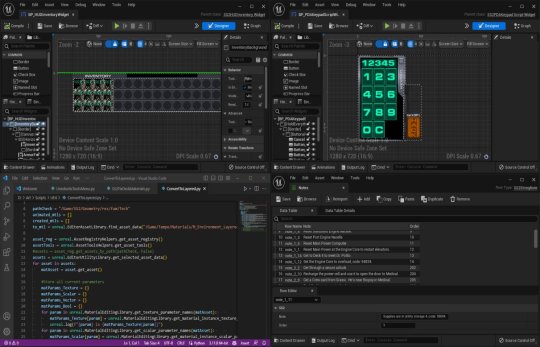
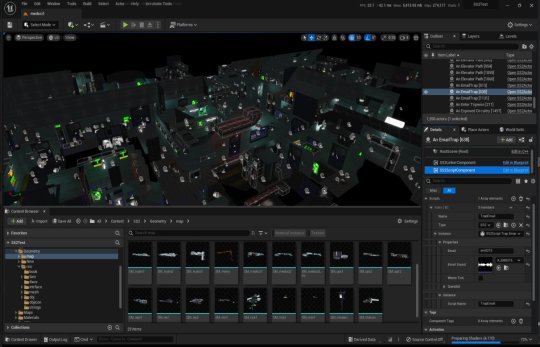
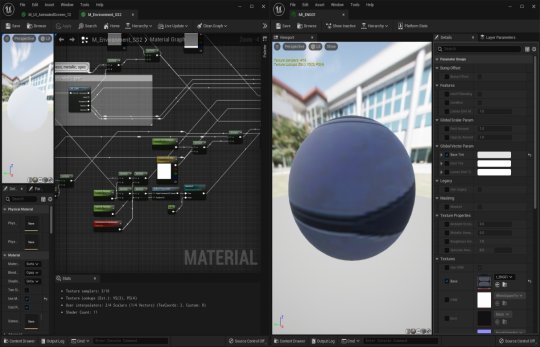

The unreal editor showcasing some of the systems and levels.
Where it's going
I kind of need to figure out exactly what I'm doing with this project and where to stop. My initial goal was just to have an explorable version of the Von Braun in Unreal Engine 5 to sharpen my game dev skills and stop them from going rusty, but it's gotten a bit further than that now. I'm also thinking of doing something much more in-depth video/blog-wise in some way - let me know in the comments if that's something you'd be interested in and what kind of stuff you'd want to see/hear about.
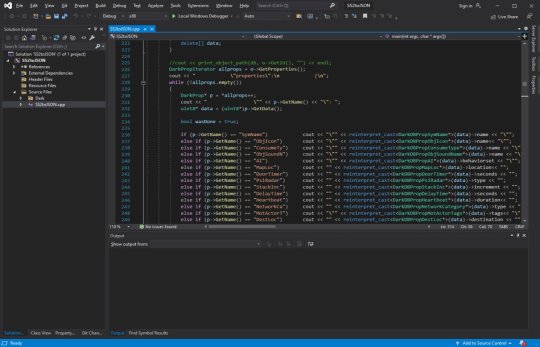
The DB to JSON tool that churns out System Shock 2 game data as readable info
Anyway - I began to expand out with the project and recreate assets and art to integrate into Unreal Engine 5. I'll add more as I get more written up.
#game development#development#programming#video game art#3ds max#retro gaming#unreal engine#ue5#indiedev#unreal engine 5#unreal editor#system shock 2#system shock#dark engine#remake#conversion#visual code#c++#json#javascript#nodejs#tools#game tools#Youtube
1 note
·
View note
Note
What are your personal headcanons on ghost cores?
ok I'm currently still mostly in the absorbing information phase, im consuming others' headcanons and sorting through what works best for me >:3 thats all to say that this is liable to change at any point, but here's what Im liking right now!
Function:
the purpose of a ghost core is to process common ectoplasm into ectoplasm coded for them
a ghost's ectosignature is a projection of their sort of individual code which is kind of like DNA (in fact it's compatible with human DNA, which is part of how hybrids work but thats a discussion for another day)
and a core absorbs ambient ectoplasm and imprints the ghost's energy pattern into it, thus making it their specific coded ectoplasm
this coding allows the ectoplasm to be shifted into the ghost's elemental state (if they have one) with a small change to its code, which is an instinctual energy change for a ghost
The core is powered by the emotional energy which comprises the "essence" of the ghost, the emotional influence from their life that allowed them to persist in the first place
let's use an example with Danny: ambient ectoplasm, both common or shed from other ghosts, is absorbed by his core. inside of it, his core lets off minute pulses of emotional energy. this leaves the processed ectoplasm. its energetic "code" is complex but let's say that its like 1011010. being his bonded ectoplasm, danny can now manipulate it in many ways, such as converting it into a pure energy form and concentrating it in his hands, readying it as an ectoblast. he can, once he's actively conscious of it, exert a tiny emotional signal which changes it from 1011010 (his signature base energy state) into 1011011. the last byte (god i really did just decide to do binary huh) representing whether it's ice-elemental. by making the change, it's now the ice version of his energy and can be used as an ice blast. the nature of his ectosignature code allows the "ice byte" to be changed freely, while a ghost with a different elemental state would not have that access to that "byte". example over :)
for hybrids, as they're still alive, their emotional impact and "soul" changes as they learn and grow. this means their ectosignatures change subtly over time, unlike full ghosts. this also means that their cores change slightly
the elemental shifting ability of coded ectoplasm means that a ghost's elemental type can be determined from their ectosignature
a ghost is made up of their coded ectoplasm, which automatically forms the right entity. this means they don't strictly need their core to survive, as long as they have enough of their own stable ectoplasm to hold form. however, they won't last long without it, since they will quickly shed off their own ectoplasm and it won't be replenished. it's kind of like a heart in that sense except every entity shares blood
Anatomy:
the core is a small sphere made of a spongy mesh of "solidified" emotional energy
it usually exists in a semi-tangible state which allows it to be contacted by phaseproof material or anything matching its tangibility state. i suppose this is just the same as normally intangible substances but even in this state it's a lot more "tangible" than emotional energy usually is
the specific emotional makeup of the ghost is reflected in the webbing patterns inside the core, though the pattern is repeated many times, so the ghost's personality and essence is based on the pattern that occurs most often. this prevents minor core damage from damaging the ghost's sense of self
however this does mean that major damage, from strained core useage, foreign energy influx, impact from something that can contact it, or something else to that effect can change the ghost's personality and powers, or more likely destabilize them
the core naturally resides in the center of the chest (or a given ghost's equivalent) but can be deliberately moved
Elements / formation:
the Dead and ghosts formed from human awareness of concepts (you know like vortex etc) have cores since they are made up of living emotions
ghosts born of other ghosts can have small cores made of parts of their parents' cores. this does mean that their parents have to lose a small part of their cores, since full ghosts can't create more living emotion to reform parts of core. anyway, young ghosts of this variety can take in living emotions they encounter to build up their own cores. this means it's good for them to spend time in the mortal realm but it also means their personality is heavily influenced by the emotions and personalities of the humans they grew up around. a ghost born of other ghosts will not mature until it has collected enough living emotion to form a full core
ghosts like blobs or whisps, which are conglomerations of ambient ectoplasm, have no core, signature energy, or hard-coded personality. they can express dead emotions and, depending on the type, feed on living emotions, and if they persist long enough form personalities.
a ghost's elemental type is determined mostly by their personality (including emotional attachments during life if theyre Dead or associations if theyre conceptual) rather than cause of death
since it's based off emotional attachments and personality values, it frequently matches up with the ghost's Obsession, which is based off emotions and thoughts during death (or the root of human belief in their concept if theyre conceptual). this however is correlation rather than causation, and odd causes of death or emotional connections can leave the elemental state and obsession having nothing to do with one another
there are other influences for elemental type such as random chance and probably other things i just dont feel like thinking up rn ive been writing this for an hour kjfhkrjfhjd
it's possible ot have a "neutral" elemental type, which just means the ghost cannot change their ectoplasm into an elementally typed form, it will just stay "base" type
thank you for asking by the way!!!! i love Talk :)
5 notes
·
View notes
Text
Create Animated Scene, Create Primitive 3D Shapes & Convert Meshes to Binary Format using Java
What’s new in this release?
Aspose is proud to expand its components family with the addition of a new product known as Aspose.3D for Java 18.5. Aspose.3D for Java API has incorporated import and export features, and developers would be able to convert their 3D models to any supported 3D formats. All readable and writable supported file formats are listed in the documentation help topics "Read 3D document" and |Save 3D document" on blog announcements page. Aspose.3D for Java API includes support of creating 3D scene from scratch, defining Metadata of the 3D scene, creating primitive 3D Shapes and visiting sub nodes to convert meshes to custom binary format. With Aspose.3D for Java API, developers can generate and store tangent and binormal data for all meshes. The tangent and bitangent are orthogonal vectors with the Normal, and instruct about the rate of change of the texture coordinates over the mesh surface. Developers can also triangulate mesh, split mesh, convert primitive shapes to meshes, encode 3D mesh in the Google Draco file, convert all Polygons to triangles and generate normal data for all meshes of 3D scene. Aspose.3D for Java API supports rendering the animated scene, and the help topic narrates prerequisites to move an object. Developers can also set up the Camera with a target to constrain. Aspose.3D for Java API supports rotating objects in a 3D scene, add node hierarchy, share geometry data of mesh between multiple nodes, concatenate Quaternions apply to 3D objects, define Mesh from scratch, set up normals or UV on objects and also add Material. This release includes plenty of new features as listed below
Define Metadata, create Primitive 3D Shapes and convert Meshes to binary format
Add Asset Information to 3D document
Create Scene with Primitive 3D Shapes
Save 3D Meshes in Custom Binary Format
Manipulate Objects in 3D Scene
Create an Animated Scene
Work with Geometric data of 3D Scene
Generate Normal Data for All Meshes of 3D Model
Convert all Polygons to triangles in 3D Model
Newly added documentation pages and articles
Some new tips and articles have now been added into Aspose.3D for Java documentation that may guide users briefly how to use Aspose.3D for performing different tasks like the followings.
Save 3D Document
Read 3D document
Overview: Aspose.3D for Java
Aspose.3D for Java is a feature-rich Gameware and Computer-Aided-Designing (CAD) API that empowers Java applications to connect with 3D document formats without requiring any 3D modeling software being installed on the server. It supports most of the popular 3D file formats, allowing developers to easily create, read, convert & modify 3D files. It helps developers in building mesh of various 3D geometric shapes; define control points and polygons in the simplest way to create 3D meshes. It empowers programmers to easily generate 3D scenes from scratch without needing to install any 3D modeling software.
More about Aspose.OCR for Java
Homepage of Aspose.3D for Java
Download Aspose.3D for Java
Online documentation of Aspose.3D for Java
#Java 3d API#Java 3d library#create Primitive 3D Shapes#convert Meshes to binary format#Define Metadata#Manipulate Objects in 3D Scene#Create an Animated Scene#Work with Geometric data of 3D Scene
0 notes
Text
How should a modern national level CFD software look like?
I come across a section in AIAA Scitech 2019 that is something I never heard of. So I spent 2 hours reading and typing what I learned from this paper that describes the new infrastructure of a CFD software.
Overall impression
It is amazing how the newest infrastructure of CFD software in a multi-disciplinary environment has become. Kestrel as an integrated product (indeed one of the products in CREATE-AV) in the CREATE (Computational Research and Engineering Acquisition Tools and Environment) program (a DoD HPC Modernization Program), it allows the interaction between
aerodynamics
dynamic stability
control
structures
propulsion
store separation
It provides a MDS (multi-disciplinary simulation) environment since 2008, so almost 9 years has been passed. This papers talks about the close relationship between its features and CFD vision 2030 by NASA.
What catches my eyes
NASA 2030 CFD vision
simulation must be multi-disciplinary
instead of traditional simulation, which is mostly similar to what we have in the university that is dubious in accuracy, non-standard inference like someone using python, others using Fortran, C++. Note that this is exactly what is still happening in China, where aerospace agencies off-load their job to university as cheap labors and thousands of graduates students in China live on that.
finally, it moves the focus of CFD to really help design groups who are facing real, complex engineering problem rather than a channel flow
therefore, current computational environment must be changed!
CFD solvers must be able to tolerate localized poor mesh with minimal user intervention.
The infrastructure should be flexible so that researchers and developers can focus on scientific and algorithm implementations
User-friendly is a forever task
The reality: high level of experts are still required to perform and understanding CFD analysis
In the DoD acquisition process, many of the target users are not really such high level of experts. Indeed, to learn a suitable amount of knowledge in the modern CFD area, it at least requires a Master degree focus on modern CFD methodologies. Especially for compressible flows with shocks, until 1980 we had no ideas how to robustly solve it.
The software standards are quite naïve from computer science perspective.
minimize the user-side data conversion
do not require user to input same information multiple times
having the best error checking system before submitting the job
XML format is chosen for input files
Having a command-line tools
Most CFD solvers even for those in-house code in the universities, also has a set of command-line tools that can do almost anything such as converting meshes between different format. I have also written a few on this during internship.
Automatic unit conversion, which is cool in OpenFOAM.
Assembled mesh preview
It is important for software that does full-scale aircraft simulation since most errors can happen during the early phase of assembling even.
In-situ visualization
It has been a hot topic in the big-data era. The main concept is to visualize information from huge data in real-time, which, on the algorithm level, requires a proper subsampling of the big data and on the infrastructure level, it requires advanced concepts of supercomputing.
How to deal with a variety of HPC system? cool features in Run-Time-Environment
PToolsRTE
It contains every dependency that is open-sourced
Just a faster way to manage packages in HPC system
AVTools
It contains every dependency that is not open-sourced.
YogiMPI
it is a universal MPI interface between a complied binary on one unknown MPI implementation with any MPI implementation available on the platform.
Note that if I am the user, I don't have to worry about the frequent changes on the HPC admin side on the default MPI implementation or versions
HealthChecker
Just something to check if the running job is not hung at some point
Frankly speaking I haven't met any of those issues like one of the node becomes corrupted then the simulation fails. But I have heard of.
Solution environment
Common Scalable Infrastructure (CSI)
CFD should be seamlessly integrated with other disciplinary code
Component-driven, event-based paradigm
Individual component is the same to CSI and a standard Python API is implemented for all components (such as CFD solver), then I think python is used a the glue.
WAND
enables multi-languages sharing for heavy data
all shared data is described in a XML format
components can be put into data-warehouse using code from one language and pull out using another languages
Parallelism for multi-body simulation
only one body is partitioned and solved on a group of processors
a separate group is assigned to each body
For example, a instance of flow solver only cares about the one body simulation, while keep the rest body simulation alone
CFD numerics
Finite volume
method of lines
semi-discrete formulation, so one can choose time stepping and spatial difference scheme separately
Fluxes
Still second order flux reconstruction, a WENO 5 scheme
various Riemann solver such as HLLE
Turbulence modeling (old-fashioned)
one equation SA
Menter two equation SST
SARC
DDES
Wall functions for improving speed, i.e., reducing the resolution at wall
Safe plan for unstable
If solution is unstable due to high gradients or poor grid, reverting everything to 1st order scheme in those areas
Collaboration environment
They developed a Kestrel SDK so one can interact with the Kestrel in many ways
Testing environment
There are 3500 unit-level tests, 250 integration level tests, over 17k assertions for all components that are monitored on a daily basis
Kestrel Automated Testing System (KATS) is executed every two weeks
it contains 125 jobs that covers a wide range of flow regimes
Reference
McDaniel, David R., Todd Tuckey, and Scott A. Morton. "The HPCMP CREATETM-AV Kestrel Computational Environment and its Relation to NASA’s CFD Vision 2030." 55th AIAA Aerospace Sciences Meeting. 2017. link
1 note
·
View note
Text
Stl Files Does not Need to Be Arduous. Read These 9 Methods Go Get A Head Begin.
Stl Files Does not Need to Be Arduous. Read These 9 Methods Go Get A Head Begin.

One other important factor to notice is that some very complicated STL models may have so many triangles that Fusion 360 won’t be in a position to cut back them with out the software program crashing. A technique to describe this is that some triangles in the mesh don't share two vertices with adjacent triangles leading to the opening. Click Mesh Modeling tab Convert Mesh panel Convert to Solid. How do you convert mesh to solid? Meshmixer is a mesh editing software from industry large boys, Autodesk. It is tempting to compare the two applications, but Netfabb is much more advanced than Meshmixer. Meshmixer also comes with a full suite of instruments for repairing STL files. OBJ also allows for NURBS paths to be calculated, which makes it a better choice for objects with easy surfaces.This increased accuracy comes on the minor expense of increased file size for the export, however OBJ remains to be considered relatively lightweight in comparison with different file codecs.One other good thing about utilizing OBJ over STL is the flexibility to transfer color knowledge, making 3D printing objects with multiple colours extra viable an possibility. What is STL for 3D printing? Step 2: Import the broken STL file to the workspace.
In some circumstances, it's possible you'll neglect to export your file to binary code, and in other circumstances it is solely not potential to choose this. However, increasing the decision of the STL export also leads to an increase in STL file measurement, which generally results in longer software program processing instances, each in generating the STL file, uploading it to Eiger, and then truly slicing the STL and getting ready it for 3D printing. On account of their lack of color and texture, STL files are usually smaller in measurement but faster at processing than different codecs. What you want to be able to do although in Blender is to analyze your model through the inventive process with the intention to check to see if it meets the specs of each your venture and your 3D printer.For example, your printer might solely be capable to create 3D objects as much as a sure peak, so in Blender, you can not create a 3D mannequin that is taller than the max size that the printer is able to create.This is straightforward to miss as a result of many people begin from the default cube when modeling and the bottom object is already 2x2x2 meters in measurement, manner too massive for any dwelling-based machine.Another issue to contemplate is using zero faces.
They started it as a mission in 2008 and it grew to be one of the most resourceful websites to get STL files to download. These STL repair files contain many instruments that you need to use to detect. Free3D is a good entry level if you are in search of royalty-free 3D fashions you should utilize in CAD or 3D and sport design. One of the areas where this easy design shines via is in preparing 3D models for Printing. Blender is also a superb free design software program that can be used for 3D printing. This mixture makes it a versatile but highly effective software for getting ready 3D models for Printing. Additionally, you will find many models for software program akin to Blender, Cinema 4D or 3ds Max. There are different options on this list that over time will develop into better options than the STL format because they will hold extra relevant information, however the convenience of use and accessibility make STL the file format that you need to learn to use first. The first thing you’ll have to do is import it into Fusion 360. There are two ways which you could import a mesh file into Fusion 360. The primary way would be to open up the info panel.
Preview Mesh: Check to preview how the mannequin can be converted to a mesh file. The STL format is definitely one of the preferred file formats for transferring 3D information between applications, however another file format that is in style for this task is the OBJ file format. It may also be used to transfer 3D knowledge for use in 3D printing, however it isn't the really helpful format to do so.Why? This can be a a lot newer file sort that some imagine to be the eventual successor of the STL format as the usual-setter for storing 3D modeling data. Print the STL file efficiently. Are you able to import an STL into blender? Can Blender be used for 3D printing? Japan based however with an English version of the web site, Rinkak focuses on premium 3D printing fashions. They have strong designs out there and greater than 18,000 free 3D printer fashions. So, utilizing these features, designers can adequately optimize the models to ensure slicing and Printing go smoothly. “File slicing” is a widely used term in 3D printing. A 3D printing model library to complement Zortrax’s vary of desktop 3D printers. To me, one of the best issues about utilizing this software program is that I can convert my designs to a 3D model after which use free CAD software program to do all of the mandatory resizing and holes preparation before sending it to a manufacturing company.
source https://creative-3d-simplification.blogspot.com/2022/05/stl-files-does-not-need-to-be-arduous.html
0 notes
Text
Import DirectX Files & Convert DirectX 3D Model to 3D Supported Formats Using Aspose.3D for .NET 17.02.0
Import DirectX Files & Convert DirectX 3D Model to 3D Supported Formats Using Aspose.3D for .NET 17.02.0
Import DirectX Files & Convert DirectX 3D Model to 3D Supported Formats Using Aspose.3D for .NET 17.02.0 It adds support of importing DirectX (.x) files. Developers can import DirectX (.x) files (ASCII and Binary) into the Aspose.3D API & then export them in any supported 3D format. The DirectX (.x) format is a template-driven format which can accommodate all 3D gaming needs, from simple mesh’s…
View On WordPress
0 notes
Text
Retrieve Bounding Box of 3D Entities & Enhanced Texture-Transparency using .NET
What’s new in this release?
Aspose team is pleased to announce the release of Aspose.3D for .NET 18.3.0. The new version 18.3 of the API has been released with the support of retrieving the bounding box of entities in 3D model. Developers can find improvement on applying transparency to the materials as well as the compatibility support among 3D formats with new APIs. With the help of Aspose.3D for .NET API, developers can apply material using per-pixel alpha channel defined in the diffuse/albedo texture. In order to achieve this, it has added Alpha and AlphaSource members. These members make it compatible with texture-transparency in 3D formats like U3D/FBX and these are also supported in Aspose.3D API renderer, since LambertMaterial, PhongMaterial and PbrMaterial classes have transparency factor. With the recent version 18.3 of Aspose.3D for .NET API, developers can retrieve a bounding box of 3D entities. This release includes plenty of new features as listed below
Order-independent transparency
Cannot render model transparency
3DS to GLTF export throws an out of index error
Add support for NURBS curve
Newly added documentation pages and articlesx
Some new tips and articles have now been added into Aspose.3D for .NET documentation that may guide users briefly how to use Aspose.3D for performing different tasks like the followings.
Create a 3D Cube Mesh and Scene
Create rectangular Torus in 3D Scene
Overview: Aspose.3D for .NET
Aspose.3D for .NET is a feature-rich component and class library for .NET that empowers Mono and .NET application including ASP.NET, Windows Forms and Web Services to connect with prevalent 3D document formats automatically without the 3D modeling and rendering software being installed on the server. It supports FBX (ASCII, Binary) and STL (ASCII, Binary) file formats and developers can easily create, read, convert, modify and control the substance of these 3D document formats using Aspose.3D API.
More about Aspose.OCR for .NET
Homepage of Aspose.3D for .NET
Download Aspose.3D for .NET
Online documentation of Aspose.3D for .NET
#Apply texture-transparency#texture-transparency per-pixel alpha channel#Create 3D Cube Mesh#Retrieve bounding box of 3D Entities#3DS to GLTF export#.NET 3d API
0 notes
Text
3D Scene Rendering in Panorama Mode with Depth & Bind Animation Curve using .NET
What’s new in this release?
Aspose team is pleased to announce the release of Aspose.3D for .NET 17.9.0. The new version 17.9 of the API has been released with the support of rendering 3D scenes in Panorama mode with depth and also enhanced the way of binding animation curve. It has enhanced the API usage by incorporating new features, enhancements and regular bug fixes. With the help of Aspose.3D for .NET API, developers can render 3D scenes in Panorama mode with depth. In order to achieve this, developers can define a vertex shader with custom script. In following help topic, Aspose team has created a camera, two light objects, define vertex shader and define position to render the depth map. The BindCurve member of the CurveMapping class allows to create the curve on the component of the animation property. In the past versions, Aspose team was using Curve class to do this and has enhanced the way of the binding curve to the specified channel. This release includes plenty of new features as listed below
Add support to uniquely identify Meshes from FBX
Add support to render scene in fully customized shaders
Improve the memory consumption when writing a large FBX file
Incorrect export OBJ with texture to GLTF and GLB
Animate properties rotation (euler) and scale for FBX format.
Newly added documentation pages and articles
Some new tips and articles have now been added into Aspose.3D for .NET documentation that may guide users briefly how to use Aspose.3D for performing different tasks like the followings.
Render 3D Scene with Panorama Mode in Depth
Add Animation Property to 3D Scene Document
Overview: Aspose.3D for .NET
Aspose.3D for .NET is a feature-rich component and class library for .NET that empowers Mono and .NET application including ASP.NET, Windows Forms and Web Services to connect with prevalent 3D document formats automatically without the 3D modeling and rendering software being installed on the server. It supports FBX (ASCII, Binary) and STL (ASCII, Binary) file formats and developers can easily create, read, convert, modify and control the substance of these 3D document formats using Aspose.3D API.
More about Aspose.OCR for .NET
Homepage of Aspose.3D for .NET
Download Aspose.3D for .NET
Online documentation of Aspose.3D for .NET
#Render 3D scene in Panorama mode#binding animation curve#memory consumption improved#export OBJ with texture to GLTF#export OBJ to GLB#.NET 3d API
0 notes
Text
3D Mesh to PLY Format Conversion & Simplifying Creation of Transform Matrix using .NET
What’s new in this release?
Aspose team is pleased to announce the release of Aspose.3D for .NET 17.07.0. The new version 17.7 of the API has been released with the support of converting a mesh of any 3D object to PLY format, also developers can simplify the creation of the transform matrix by calling newly added methods in the Matrix4 class. The PLY format describes an object as a collection of vertices, faces and other elements, along with properties such as color and normal direction that can be attached to these elements. A PLY file contains the description of exactly one object. Aspose.3D for .NET API has support of retrieving the mesh of any existing 3D object. With the help this new API version 17.7, developers can convert that mesh to PLY file. Typically, developers might need a sequence of transformations to position 3D objects in a scene. With the help of this new API version 17.7, they can compose a matrix in two transformation orders known as Append and Prepend. Besides this, the bug fixes have improved the rendering of FBX files and also preserves UVs in respective of the 3DS Max modeling tool. This release includes plenty of new features as listed below
Add support of exporting 3D scene to PLY format.
Simplify the creation of transform matrix.
Allow generate mesh from grayscale image as a height map.
The FBX file generated cannot be edited by 3ds max.
UVs are corrupted when exporting a scene in FBX format.
Newly added documentation pages and articles
Some new tips and articles have now been added into Aspose.3D for .NET documentation that may guide users briefly how to use Aspose.3D for performing different tasks like the followings.
Convert Mesh of a single 3D object in PLY file
Simplify the creation of transformation matrix by the chain operations
Overview: Aspose.3D for .NET
Aspose.3D for .NET is a feature-rich component and class library for .NET that empowers Mono and .NET application including ASP.NET, Windows Forms and Web Services to connect with prevalent 3D document formats automatically without the 3D modeling and rendering software being installed on the server. It supports FBX (ASCII, Binary) and STL (ASCII, Binary) file formats and developers can easily create, read, convert, modify and control the substance of these 3D document formats using Aspose.3D API.
More about Aspose.OCR for .NET
Homepage of Aspose.3D for .NET
Download Aspose.3D for .NET
Online documentation of Aspose.3D for .NET
#Convert 3D mesh to PLY format#compose a transformation matrix#enerate mesh from grayscale image#exporting a scene in FBX#.NET 3d API#.NET 3D library#3D modeling in .NET
0 notes
Text
Convert Google Draco Encoded DRC File to 3D Supported Formats inside .NET Applications
What’s new in this release?
Aspose team is pleased to announce the release of Aspose.3D for .NET 17.03.0. The new version adds support of importing Google Draco encoded DRC files. Developers can import DRC files into the Aspose.3D API, and then export them in any supported 3D format. Developers can install Aspose.3D Nuget package in their .NET applications because Aspose team publish each version as a NuGet package on the NuGet gallery. The Google Draco, an open source compression library, can improve the storage and transmission of 3D graphics. Draco can be used to compress meshes and point-cloud data. It also supports compressing points, connectivity information, texture coordinates, color information, normals and any other generic attributes associated with geometry. Draco encodes 3D data in DRC file. Using Aspose.3D API, developers can convert a Draco encoded DRC to 3D supported formats. All supported 3D formats are listed on the documentation page title save a 3D Document. This help topic “Reading a 3D Scene” will help to know the way of importing an existing DRC file. This release includes plenty of new features as listed below
Add support of importing Google Draco (.drc) files.
Enhanced Reading a 3D Scene
Add support of importing the DXF.
Newly added documentation pages and articles
Some new tips and articles have now been added into Aspose.3D for .NET documentation that may guide users briefly how to use Aspose.3D for performing different tasks like the followings.
Save a 3D Document
Reading a 3D Scene
Overview: Aspose.3D for .NET
Aspose.3D for .NET is a feature-rich component and class library for .NET that empowers Mono and .NET application including ASP.NET, Windows Forms and Web Services to connect with prevalent 3D document formats automatically without the 3D modeling and rendering software being installed on the server. It supports FBX (ASCII, Binary) and STL (ASCII, Binary) file formats and developers can easily create, read, convert, modify and control the substance of these 3D document formats using Aspose.3D API.
More about Aspose.OCR for .NET
Homepage of Aspose.3D for .NET
Download Aspose.3D for .NET
#Import Google Draco Encoded DRC Files#Export Google Draco to 3D Formats#Creating 3D Scene Document#Save 3D Document#Reading a 3D Scene#.NET 3d API
0 notes
Text
Import DirectX Files & Convert DirectX 3D Model to 3D Supported Formats inside .NET Apps
What’s new in this release?
Aspose team is pleased to announce the release of Aspose.3D for .NET 17.02.0. The new version adds support of importing DirectX (.x) files. Developers can import DirectX (.x) files (ASCII and Binary) into the Aspose.3D API, and then export them in any supported 3D format. Developers can install Aspose.3D Nuget package in their .NET applications because we publish each version as a NuGet package on the NuGet gallery. The X file format refers to files with the .x file name extension. The DirectX (.x) format is a template-driven format which can accommodate all your 3D gaming needs, from simple mesh’s to complete bone animation characters. Using Aspose.3D API, developers can convert a DirectX (.x) 3D model to 3D supported formats. All supported 3D formats are listed on this page: Save a 3D Document. These help topics will help to know the way of importing an existing X file, Reading a 3D Scene and Specify Load Options of 3D DirectX .x File. This release includes plenty of new features as listed below
Add support of importing the X (binary and ASCII) files.
Enhanced Reading a 3D Scene
Import an Existing PLY File into the Aspose.3D API
Add support of importing the DXF.
Newly added documentation pages and articles
Some new tips and articles have now been added into Aspose.3D for .NET documentation that may guide users briefly how to use Aspose.3D for performing different tasks like the followings.
Save a 3D Document
Reading a 3D Scene
Overview: Aspose.3D for .NET
Aspose.3D for .NET is a feature-rich component and class library for .NET that empowers Mono and .NET application including ASP.NET, Windows Forms and Web Services to connect with prevalent 3D document formats automatically without the 3D modeling and rendering software being installed on the server. It supports FBX (ASCII, Binary) and STL (ASCII, Binary) file formats and developers can easily create, read, convert, modify and control the substance of these 3D document formats using Aspose.3D API.
More about Aspose.OCR for .NET
Homepage of Aspose.3D for .NET
Download Aspose.3D for .NET
#importing DirectX files#export DirectX to 3D format#Save a 3D Document#Reading a 3D Scene#import existing X file#.NET 3d API#.NET 3D Component
0 notes
Text
Load 3D File & Save Meshes in Custom Binary Format & Import an Existing PLY File in .NET Apps
What’s new in this release?
Aspose team is pleased to announce the release of Aspose.3D for .NET 17.01. The new version adds support of importing PLY models. Developers can import PLY (ASCII and Binary) models into the Aspose.3D API, and then export them in any supported 3D format. The new version also integrates the feature of writing 3D file in the custom binary mode. All the regular bug fixes and enhancements have also been included. Using Aspose.3D for .NET API, developers can already load all supported 3D files. Developers can also retrieve meshes and the new public API changes allow to save the meshes in custom binary format. The binary file size remains same as the data we store like the minimum workable size. This feature would also help Aspose clients manipulate bigger 3D models more effectively. PLY is a computer file format known as the Polygon File Format or the Stanford Triangle Format. It is one of simplest format to read and write a 3D mesh. Using Aspose.3D API, developers can now import any existing PLY (ASCII or Binary) model. Developers would also be able to load a PLY file, and then save in any supported 3D file format. Please check these help topics to know how to import an existing PLY file: Reading a 3D Scene and Specify Load Options of 3D PLY. This release includes plenty of new features as listed below
Add support of importing the PLY models
Load 3D File and Save Meshes in Custom Binary Format
Import an Existing PLY File into the Aspose.3D API
Add support of importing the DXF.
Newly added documentation pages and articles
Some new tips and articles have now been added into Aspose.3D for .NET documentation that may guide users briefly how to use Aspose.3D for performing different tasks like the followings.
Save 3D Meshes in Custom Binary Format
Use of the Ply Load Options
Overview: Aspose.3D for .NET
Aspose.3D for .NET is a feature-rich component and class library for .NET that empowers Mono and .NET application including ASP.NET, Windows Forms and Web Services to connect with prevalent 3D document formats automatically without the 3D modeling and rendering software being installed on the server. It supports FBX (ASCII, Binary) and STL (ASCII, Binary) file formats and developers can easily create, read, convert, modify and control the substance of these 3D document formats using Aspose.3D API.
More about Aspose.OCR for .NET
Homepage of Aspose.3D for .NET
Download Aspose.3D for .NET
#Load 3D File#Save Meshes in Custom Binary#Import Existing PLY File#Load Options of 3D PLY#write 3D file in custom binary#.NET 3d API#.NET 3D Component#read and write 3D mesh
0 notes